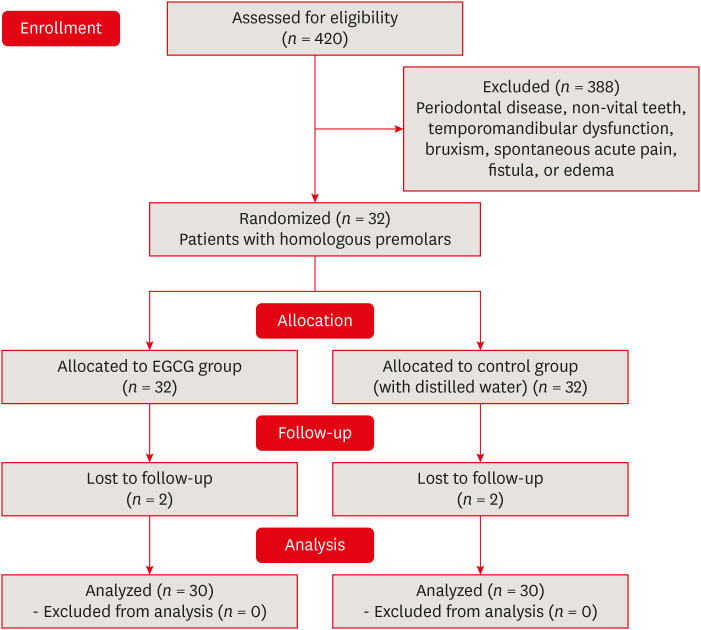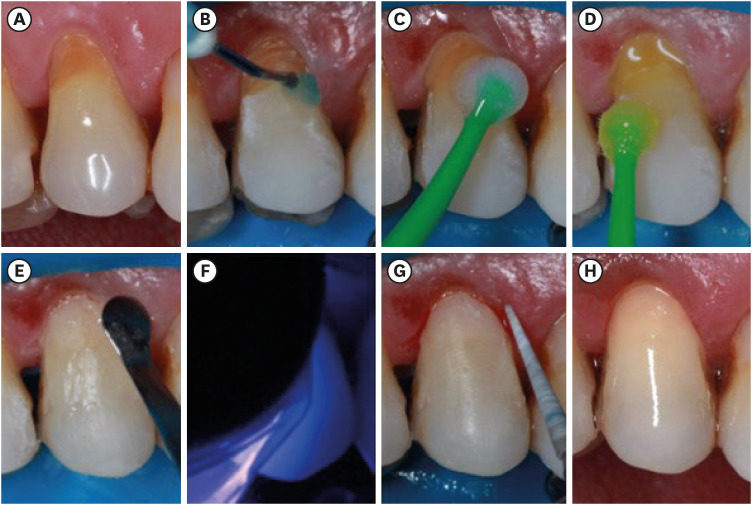Restor Dent Endod.
2023 May;48(2):e13. 10.5395/rde.2023.48.e13.
Epigallocatechin-3-gallate prior to composite resin in abfraction lesions: a split-mouth randomized clinical trial
- Affiliations
-
- 1Department of Restorative Dentistry, Ribeirão Preto School of Dentistry, University of São Paulo, Ribeirão Preto, SP, Brazil
- KMID: 2548216
- DOI: http://doi.org/10.5395/rde.2023.48.e13
Abstract
Objectives
Natural extracts have been investigated as a biomimetic strategy to mechanically strengthen the collagen network and control the biodegradation of extracellular matrix. This study evaluated the effect of epigallocatechin-3-gallate (EGCG) on abfraction lesions prior to the composite resin.
Materials and Methods
The sample consisted of 30 patients (aged between 28 and 60 years) with abfraction lesions located in 2 homologous premolars. The teeth were randomly assigned according to dentin treatment: 0.02% EGCG solution or distilled water (control). After enamel acid etching, the solutions were applied immediately for 1 minute. The teeth were restored with Universal Adhesive (3M) and Filtek Z350 XT (3M). Analyzes were done by 2 independent examiners using modified USPHS (retention, secondary caries, marginal adaptation, and postoperative sensitivity) and photographic (color, marginal pigmentation, and anatomical form) criteria at baseline (7 days) and final (18 months). The data analysis used Friedman and Wilcoxon signed-rank tests (α = 0.05).
Results
At baseline, all restorations were evaluated as alpha for all criteria. After 18 months, restorations were evaluated as alpha for secondary caries, color, and marginal pigmentation.cThere was significant difference between baseline and 18 months (p = 0.009) for marginal adaptation and postoperative sensitivity (p = 0.029), but no significant difference were verified between treatments (p = 0.433). The EGCG group had a restoration retention rate of 93.3%, while the control group had 96.7%.
Conclusions
The application of EGCG solution on abfraction lesions did not significantly influence the survival of the restorations based on clinical and photographic criteria.
Keyword
Figure
Reference
-
1. Francisconi LF, Graeff MS, Martins LM, Franco EB, Mondelli RF, Francisconi PA, Pereira JC. The effects of occlusal loading on the margins of cervical restorations. J Am Dent Assoc. 2009; 140:1275–1282. PMID: 19797558.
Article2. Badavannavar AN, Ajari S, Nayak KU, Khijmatgar S. Abfraction: Etiopathogenesis, clinical aspect, and diagnostic-treatment modalities: a review. Indian J Dent Res. 2020; 31:305–311. PMID: 32436913.
Article3. Michael JA, Townsend GC, Greenwood LF, Kaidonis JA. Abfraction: separating fact from fiction. Aust Dent J. 2009; 54:2–8. PMID: 19228125.
Article4. Peumans M, Politano G, Van Meerbeek B. Treatment of noncarious cervical lesions: when, why, and how. Int J Esthet Dent. 2020; 15:16–42. PMID: 31994534.5. Rees JS, Hammadeh M. Undermining of enamel as a mechanism of abfraction lesion formation: a finite element study. Eur J Oral Sci. 2004; 112:347–352. PMID: 15279654.
Article6. Romeed SA, Malik R, Dunne SM. Stress analysis of occlusal forces in canine teeth and their role in the development of non-carious cervical lesions: abfraction. Int J Dent. 2012; 2012:234845. PMID: 22919387.
Article7. Rusu Olaru A, Popescu MR, Dragomir LP, Rauten AM. Clinical study on abfraction lesions in occlusal dysfunction. Curr Health Sci J. 2019; 45:390–397. PMID: 32110441.8. Wood I, Jawad Z, Paisley C, Brunton P. Non-carious cervical tooth surface loss: a literature review. J Dent. 2008; 36:759–766. PMID: 18656296.
Article9. Reyes-Gasga J, Galindo-Mentle M, Brès E, Vargas-Becerril N, Orozco E, Rodríguez-Gómez A, García-García R. Detection of the piezoelectricity effect in nanocrystals from human teeth. J Phys Chem Solids. 2020; 136:109140.
Article10. Grippo JO, Chaiyabutr Y, Kois JC. Effects of cyclic fatigue stress-biocorrosion on noncarious cervical lesions. J Esthet Restor Dent. 2013; 25:265–272. PMID: 23910184.
Article11. Matuda LS, Marchi GM, Aguiar TR, Leme AA, Ambrosano GM, Bedran-Russo AK. Dental adhesives and strategies for displacement of water/solvents from collagen fibrils. Dent Mater. 2016; 32:723–731. PMID: 27068741.
Article12. Yiu CK, King NM, Pashley DH, Suh BI, Carvalho RM, Carrilho MR, Tay FR. Effect of resin hydrophilicity and water storage on resin strength. Biomaterials. 2004; 25:5789–5796. PMID: 15147825.
Article13. Prakki A, Xiong Y, Bortolatto J, Gonçalves LL, Bafail A, Anderson G, Stavroullakis AT. Functionalized epigallocatechin gallate copolymer inhibit dentin matrices degradation: mechanical, solubilized telopeptide and proteomic assays. Dent Mater. 2018; 34:1625–1633. PMID: 30201286.
Article14. Breschi L, Mazzoni A, Ruggeri A, Cadenaro M, Di Lenarda R, De Stefano Dorigo E. Dental adhesion review: aging and stability of the bonded interface. Dent Mater. 2008; 24:90–101. PMID: 17442386.
Article15. Zhang Z, Yu J, Yao C, Yang H, Huang C. New perspective to improve dentin-adhesive interface stability by using dimethyl sulfoxide wet-bonding and epigallocatechin-3-gallate. Dent Mater. 2020; 36:1452–1463. PMID: 32943231.
Article16. Kato MT, Leite AL, Hannas AR, Calabria MP, Magalhães AC, Pereira JC, Buzalaf MA. Impact of protease inhibitors on dentin matrix degradation by collagenase. J Dent Res. 2012; 91:1119–1123. PMID: 23023765.
Article17. Vidal CM, Aguiar TR, Phansalkar R, McAlpine JB, Napolitano JG, Chen SN, Araújo LS, Pauli GF, Bedran-Russo A. Galloyl moieties enhance the dentin biomodification potential of plant-derived catechins. Acta Biomater. 2014; 10:3288–3294. PMID: 24721612.
Article18. Zarella BL, Buzalaf MA, Kato MT, Hannas AR, Salo T, Tjäderhane L, Prakki A. Cytotoxicity and effect on protease activity of copolymer extracts containing catechin. Arch Oral Biol. 2016; 65:66–71. PMID: 26867224.
Article19. Mankovskaia A, Lévesque CM, Prakki A. Catechin-incorporated dental copolymers inhibit growth of Streptococcus mutans. J Appl Oral Sci. 2013; 21:203–207. PMID: 23739855.
Article20. Santiago SL, Osorio R, Neri JR, Carvalho RM, Toledano M. Effect of the flavonoid epigallocatechin-3-gallate on resin-dentin bond strength. J Adhes Dent. 2013; 15:535–540. PMID: 23560257.21. Du X, Huang X, Huang C, Wang Y, Zhang Y. Epigallocatechin-3-gallate (EGCG) enhances the therapeutic activity of a dental adhesive. J Dent. 2012; 40:485–492. PMID: 22421091.
Article22. Hiraishi N, Sono R, Sofiqul I, Yiu C, Nakamura H, Otsuki M, Takatsuka T, Tagami J. In vitro evaluation of plant-derived agents to preserve dentin collagen. Dent Mater. 2013; 29:1048–1054. PMID: 23942145.23. Jackson JK, Zhao J, Wong W, Burt HM. The inhibition of collagenase induced degradation of collagen by the galloyl-containing polyphenols tannic acid, epigallocatechin gallate and epicatechin gallate. J Mater Sci Mater Med. 2010; 21:1435–1443. PMID: 20162329.
Article24. de Souza JC, Tedesco AC, Takahashi LA, Curylofo-Zotti FA, Souza-Gabriel AE, Corona SA. Influence of nanoparticulated chitosan on the biomodification of eroded dentin: clinical and photographic longitudinal analysis of restorations. J Mater Sci Mater Med. 2021; 32:11. PMID: 33471208.
Article25. Lynch CD, O’Sullivan VR, Dockery P, McGillycuddy CT, Sloan AJ. Hunter-Schreger Band patterns in human tooth enamel. J Anat. 2010; 217:106–115. PMID: 20579171.
Article26. De Moraes MD, Passos VF, Padovani GC, Bezerra LC, Vasconcelos IM, Santiago SL. Protective effect of green tea catechins on eroded human dentin: an in vitro/in situ study. Braz Oral Res. 2021; 35:e108. PMID: 34816896.
Article27. Costa CA, Passos VF, Neri JR, Mendonça JS, Santiago SL. Effect of metalloproteinase inhibitors on bond strength of a self-etching adhesive on erosively demineralized dentin. J Adhes Dent. 2019; 21:337–344. PMID: 31432048.28. Neri JR, Yamauti M, da Silveira FD, Mendonca JS, de Carvalho RM, Santiago SL. Influence of dentin biomodification with epigallocatechin-3-gallate on the bond strength of self-etch adhesive: twelve-month results. Int J Adhes Adhes. 2016; 71:81–86.
Article29. Epasinghe DJ, Yiu CK, Burrow MF, Tay FR, King NM. Effect of proanthocyanidin incorporation into dental adhesive resin on resin-dentine bond strength. J Dent. 2012; 40:173–180. PMID: 22155037.
Article30. Hardan L, Daood U, Bourgi R, Cuevas-Suárez CE, Devoto W, Zarow M, Jakubowicz N, Zamarripa-Calderón JE, Radwanski M, Orsini G, Lukomska-Szymanska M. Effect of collagen crosslinkers on dentin bond strength of adhesive systems: a systematic review and meta-analysis. Cells. 2022; 11:2417. PMID: 35954261.
Article31. de Souza LC, Rodrigues NS, Cunha DA, Feitosa VP, Santiago SL, Reis A, Loguercio AD, Matos TP, Saboia VP, Perdigão J. Two-year clinical evaluation of proanthocyanidins added to a two-step etch-and-rinse adhesive. J Dent. 2019; 81:7–16. PMID: 30594631.
Article32. Yang H, Guo J, Deng D, Chen Z, Huang C. Effect of adjunctive application of epigallocatechin-3-gallate and ethanol-wet bonding on adhesive-dentin bonds. J Dent. 2016; 44:44–49. PMID: 26655074.
Article33. Costa C, Albuquerque N, Mendonça JS, Loguercio AD, Saboia V, Santiago SL. Catechin-based dentin pretreatment and the clinical performance of a universal adhesive: a two-year randomized clinical trial. Oper Dent. 2020; 45:473–483. PMID: 32352353.
Article34. Souza-Junior EJ, Prieto LT, Araújo CT, Paulillo LA. Selective enamel etching: effect on marginal adaptation of self-etch LED-cured bond systems in aged Class I composite restorations. Oper Dent. 2012; 37:195–204. PMID: 22313271.
Article35. Carvalho RV, Ogliari FA, de Souza AP, Silva AF, Petzhold CL, Line SR, Piva E, Etges A. 2-hydroxyethyl methacrylate as an inhibitor of matrix metalloproteinase-2. Eur J Oral Sci. 2009; 117:64–67. PMID: 19196320.
Article36. Gerhardt KM, Oliveira CA, França FM, Basting RT, Turssi CP, Amaral FL. Effect of epigallocatechin gallate, green tea extract and chlorhexidine application on long-term bond strength of self-etch adhesive to dentin. Int J Adhes Adhes. 2016; 71:23–27.
Article37. Fialho MP, Hass V, Nogueira RP, França FM, Turssi CP, Basting RT, Amaral FL. Effect of epigallocatechin-3- gallate solutions on bond durability at the adhesive interface in caries-affected dentin. J Mech Behav Biomed Mater. 2019; 91:398–405. PMID: 30669058.
Article38. Nivedita L, Prakash V, Mitthra S, Pearlin Mary NS, Venkatesh A, Subbiya A. Evaluation of the effect of collagen stabilizing agents like chitosan and proanthocyanidin on the shear bond strength to dentin and microleakage of resin composite at enamel and cemental walls: an in vitro study. J Conserv Dent. 2019; 22:483–489. PMID: 33082667.
Article
- Full Text Links
- Actions
-
Cited
- CITED
-
- Close
- Share
- Similar articles
-
- Effect of the marginal position of prosthesis on stress distribution of teeth with abfraction lesion using finite element analysis
- Effect of Epigallocatechin Gallate on shear bond strength of composite resin to bleached enamel: an in vitro study
- Transactivation of peroxisome proliferator-activated receptor alpha by green tea extracts
- Utilization of Resin Infiltration for the Minimally Invasive Composite Restoration
- Effect of Epigallocatechin Gallate on Viability of Kudoa septempunctata



